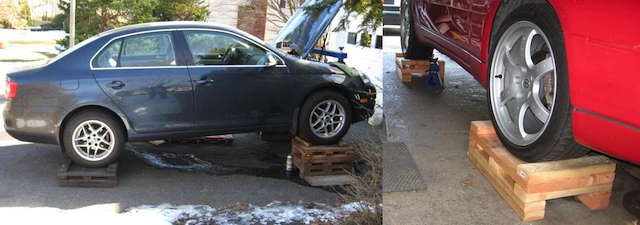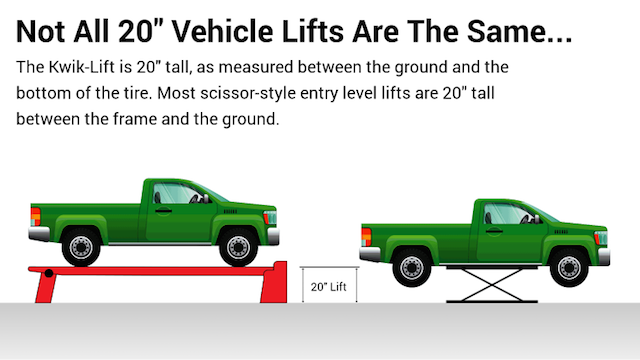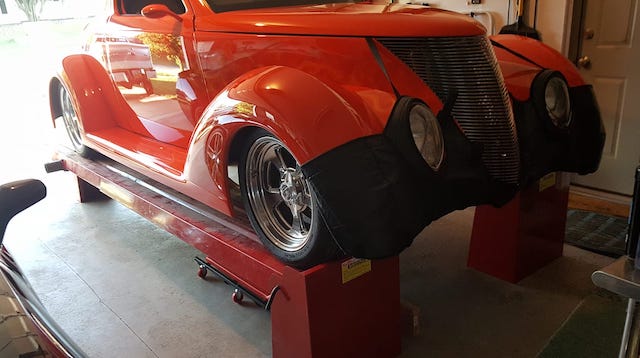
Picking a car lift can be challenging for a homeowner looking to do some DIY car maintenance at home. There are so many different factors to consider – size, portability, compatibility, to name a few – and picking the right lift can be daunting. That’s why we’re here.
Consider this your go-to guide on five different home car lifts. Here, you’ll get a brief explanation of each type of lift and a list of pros and cons for each one.
1. A Commercial Grade 2-Post Lift
The 2-post lift is the most popular lift in commercial use today, and the reason is that it has a lot of benefits.
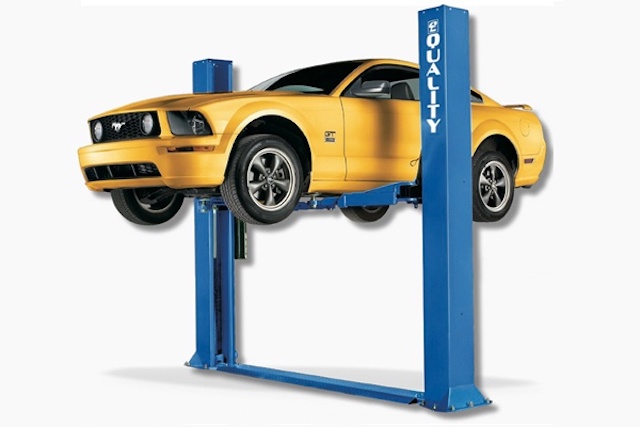
Pros of Using a 2-Post Lift
The pros use 2 post lifts for a reason – they’re great:
- Excellent Usability. A modern 2-post lift can pick up just about any vehicle and provide excellent access to the vehicle underbody. They work great with all types of modern vehicles, and can usually lift older cars too (only sometimes that can be an issue if the lift points are too far inboard).
- Excellent Reliability: A commercial grade 2-post lift is meant to operate multiple times per day. For a home user, odds are good that a commercial lift will last a lifetime.
- Reasonable Pricing: Considering just how awesome these lifts are, their $2000 to $2500 cost is very reasonable.
Cons of Using a 2-Post Lift
If you’re a commercial shop owner looking for a 2 post lift, there aren’t too many ‘cons’ to talk about.
But, if you’re a home owner looking for a lift to put in your garage, there are some things to know:
- 2 Post Lifts Are Wide AND Tall: You can’t really install a 2 post lift in a standard sized residential garage. Most of them require a ceiling height of 12 feet (or more), and a space that’s also about 12 feet wide. There are some ‘narrow’ 2 post lifts that can fit in a space as little as 10 feet wide, but that’s usually too wide for a home garage.
- Concrete Slab Requirements: A commercial 2 post lift should be bolted to a 4-6″ thick slab of 3,000 PSI concrete. If it isn’t, it could have serious safety repercussions. For home garages, this typically means a new slab of concrete is needed.
- Maintenance: It’s not a big deal, but anyone with a commercial lift needs to conduct regular inspections and maintenance. Every few years, wire ropes and rollers will need to be replaced. However, since the lift is commercial grade, replacement parts are easy enough to find.
If your garage can accommodate a real commercial 2 post lift, we think they’re great. You can see what we have to offer in 2 post lifts by clicking here.
2. A Commercial Grade 4-Post Lift
Much like a 2-post lift, a commercial grade 4-post lift is great if you have a garage that can accommodate it.

Pros of Using a 4-Post Lift
Check out some of the pros that come with owning a 4-post lift:
- Great For Storage: 4 post lifts are often used to “create” space in a home garage by lifting a vehicle up into unused space near the ceiling. You can even store a second vehicle by stacking it under the first.
- Great For Serious Work: Much like a 2 post lift, a 4 post lift offers complete access to the underside of a vehicle.
- Great For Low Ground Clearance: If you’re lifting a car with very little ground clearance, a 4 post lift is often the only way to go.
- Safety and Stability: Lifting a vehicle by it’s tires is one of the safest ways to get it up in the air. Supporting the weight at four corners is also extremely safe.
- Weight Capacity: Because of the design of a 4 post lift – and the support at four corners – they can usually hold more weight than any other type of lift.
Cons of Using a 4-Post Lift
If you’re a commercial user, the downside to having a 4 post lift is that it isn’t a 2 post lift. If you’re a homeowner, the cons are:
- 4 Post Lifts Are Tall: It’s hard to install a 4 post lift in a typical home garage, as they require 12′ (or higher) ceilings, depending on the height of the vehicles. For example, it would be possible to stack two Corvettes in a 10′ garage, but you wouldn’t have any space to work on either vehicle.
- 4 Post Lifts are Wide Too: Even though a typical 4 post lift isn’t as wide as a typical 2 post lift, it’s still usually too wide for a standard home garage space. Most of them require 10 feet of width.
- 4 Post Lifts are More Expensive: Because of the additional materials, 4 post lifts tend to be a bit more costly than 2 posts lifts.
- 4 Post Lifts Make Wheel and Tire Work More Difficult: Unlike a 2 post lift, a 4 post lift holds the vehicle up by its wheels. Removing a wheel or wheels requires extra steps with a 4 post lift.
Just like commercial grade 2 post lifts, we think a commercial grade 4 post lift is a great idea if you can fit it into you garage. You can see the 4 post lifts we offer by clicking here.
3. Scissor-Style Entry Level Hydraulic Lifts
Entry-level hydraulic lifts typically lift a car between the wheels. They can either be one lift or (more commonly) two separate lifts, and they use a ‘scissor’ style lift mechanism.
Pros of Using an Entry Level Hydraulic Lift
Entry-level hydraulic lifts have a couple of benefits.
- Great for light maintenance: If you’re looking for a lift that’s perfect for rotating tires quickly and easily, replacing brake pads, or getting a car up high enough to do a quick lube oil and filter, these types of lifts are great.
- Great for garages with low ceilings. If you’ve got a typical residential garage, odds are good you can’t install a 2 post or 4 post lift due to the height of your ceiling. This type of lift avoids that problem.
- Great for showing off: Want to be the coolest kid on the block (or at the track)? Roll your scissor style lift(s) under your car, position it between the wheels, and push the button. As long as the lift works correctly, you’ll have a nice showpiece.
Cons of Using an Entry Level Hydraulic Lift
Like everything, there are downsides to an entry-level hydraulic lift. However, these lifts have more downsides than just about any other option on the market.
- They Use Cheap Hydraulic Systems: A lot of entry level hydraulic lifts cut costs on hydraulics. This makes sense because hydraulics are by far the most expensive components in a hydraulic lift. The problem is, cheap hydraulics break down quickly with regular use (not to mention, the fittings leak too).
- Minimal Lift Height: Since entry level hydraulic lifts are designed to lift a car by its frame – and because they typically don’t lift more than 18 inches – they don’t offer much access underneath. You can definitely get a creeper under a car with an entry-level scissor style lift, but you won’t have room to drop a transmission (or similar). Of course, you can always enlist the help of blocks on top of the lift, but they can get wobbly.
- Tipping Front to Back: Speaking of wobbly lifts, entry level lifts that sit between the wheels can have problems tipping front to back. This is particularly a problem on vehicles with a long wheelbase or weight bias that isn’t 50-50. Tipping is also a concern when the engine is removed, or even when the rear end is removed.
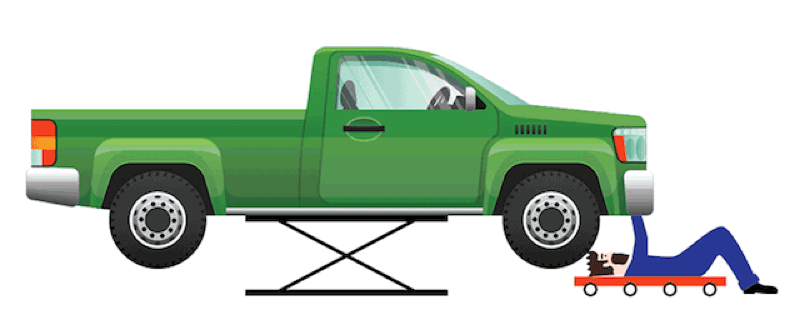
- They Don’t Work For Low Ground Clearance Vehicles: While most of the companies selling entry level hydraulic lifts say that they can lay flat, the fully collapsed “flat” height of these lifts is 3 or 4 inches. What’s more, they can’t usually lift a vehicle from the fully collapsed position. So, if you’ve got a vehicle with 5 inches of ride height or less, this type of lift probably isn’t a good choice.
- Failure During Raise Or Lower (Twin Styles Only): Entry level lifts that have two sides (twin style) can have problems with uneven performance during lowering or lifting. If, for example, one side of the lift becomes “stuck,” the vehicle can fall off the lift during raise or lower.
- Restricted Underbody Access: Because entry level lifts pick up a vehicle by it’s frame, they restrict access to the underside of the vehicle.
As we said, entry-level scissor style hydraulic lifts are great for light maintenance, but they have a lot of problems that crop up during serious use. We definitely don’t recommend these lifts to anyone, as they tend to be all “show” and no “go.”
4. Kwik-Lift
Last but definitely not least, we have the Kwik-Lift: a strong and reliable drive-on car lift that is great for anyone working in garage with a low ceiling.
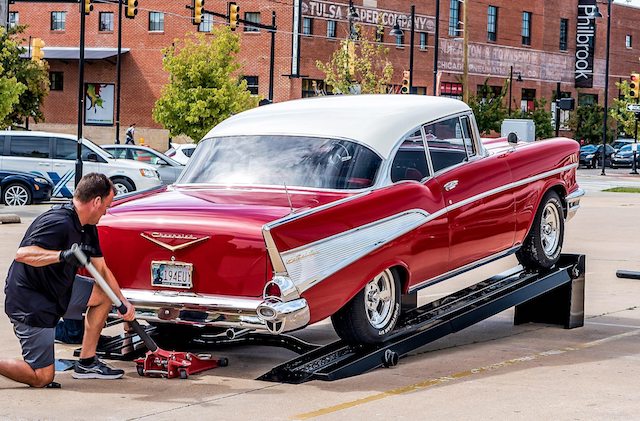
Pros of Using a Kwik-Lift
While we’re biased, we think the Kwik-Lift has a lot of advantages.
- Safety and Stability: The Kwik-Lift is wide for it’s size, and each side of the lift is connected to the other side via the lift tube. The lift tube connects the ramps to keep them at the same height from left to right for a level work surface. As a result, it’s a very sturdy platform. What’s more, the lift works at the tires rather than at the frame. Long wheelbase? Uneven weight distribution? No problem.
- Easy to Use For Real Work: The Kwik-Lift offers 20″ of lift between the bottom of the tire and the ground. That works out to 24-28″ of height between the bottom of the frame and the ground, which is just about perfect for whatever you might need to do. There’s plenty of space to drop a transmission, for example.
- Works With Nearly Any Vehicle: Because the Kwik-Lift is basically a ramp, it works for vehicles with low ground clearance. Because the Kwik-Lift is adjustable in length and width, it works for nearly any car that’s ever been built.
- Reliability: The Kwik-Lift is not powered by hydraulics or electricity at all. Just periodically lubricate the moving parts, and keep it painted. No hydraulic fluid leaks, no motors to replace, etc.
- True Portability: A lot of entry-level lifts for home use claim to be portable but usually require a buddy to load and unload due to their weight. Since the Kwik-Lift breaks down into a few pieces, it’s easy for one person to disassemble it and load it into a standard pickup bed, then reassemble.
- True Flat Folding: If you’re looking at a Kwik-Lift, you probably want a lift that you can either a) set aside or b) park on top of. The Kwik-Lift folds down completely so that it’s easy to park on.
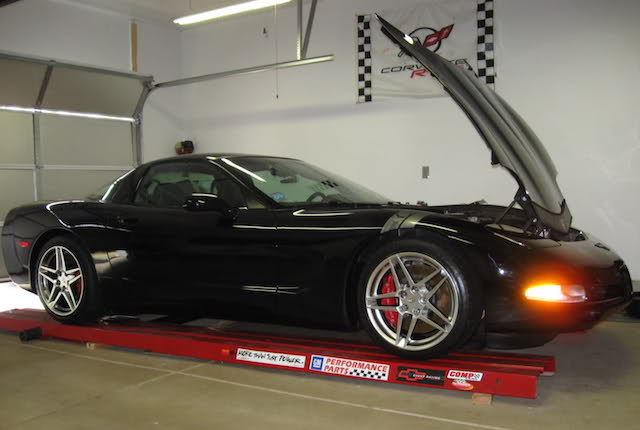
Cons of Using a Kwik-Lift
The Kwik-Lift has at least one drawback:
- No Gee-Whiz Buttons to Push: Kwik-Lifts are as practical as they come. That means no hydraulics, electricity, or fancy buttons to play with. Many car lift owners value safety and practicality above technology, so this isn’t much of an issue for many.
Additionally, some people say the price of the Kwik-Lift is a ‘con,’ as it’s nearly as much to buy a Kwik-Lift as it is a scissor-style lift with entry-level hydraulics. While this is true, the Kwik-Lift is solid steel and Made In The USA. The quality is top notch.
And, because of this quality, and because there are no moving parts or pumps that can fail, it’s easy to resell a Kwik-Lift for a lot more than any used hydraulic lift.
Summing Up
If your home garage has the space for a commercial grade 2 post or 4 post lift, we definitely think they’re a good choice. Just be sure to invest in an actual commercial lift, as the cheap alternatives for ‘home’ users really don’t save any money.
If your home garage isn’t big enough for a commercial 2 post or 4 post, beware the entry-level scissor style lifts. A lot of the companies selling these lifts have slick marketing and impressive videos, but they hide the fact that these types of lifts aren’t very usable.
If you’ve got a garage with a low ceiling – or if you’re looking for a simple and reliable lift that doesn’t have any hydraulics – the Kwik-Lift is the way to go.
NOTE: We hope this guide has helped you reach an informed decision on which car lift is right for you. If you need any more help choosing a car lift for your home garage, feel free to contact us.


